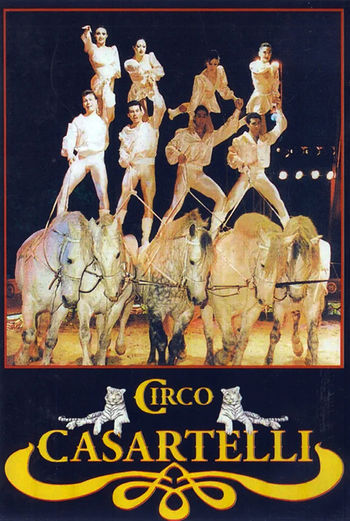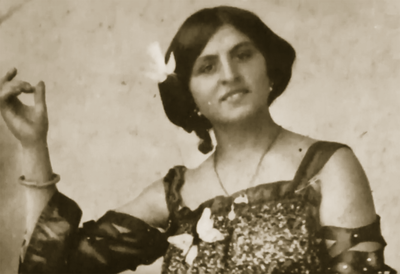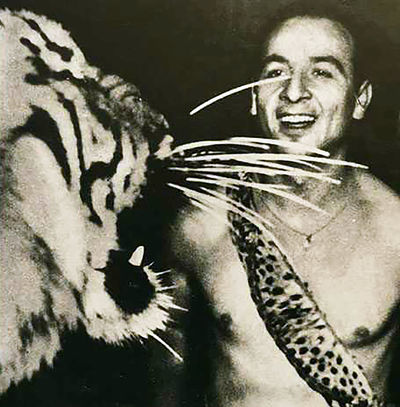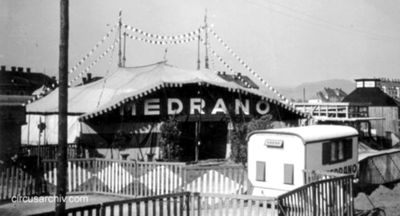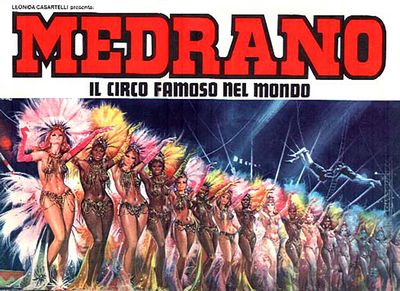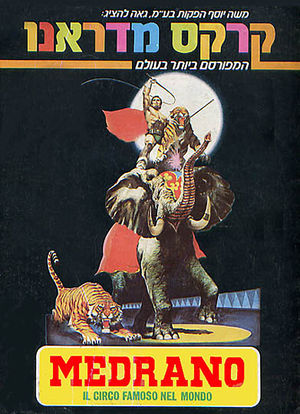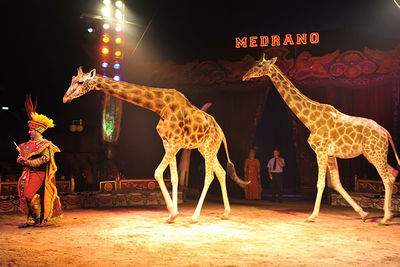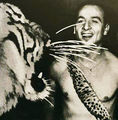The Casartelli Family
From Circopedia
By Raffaele de Ritis
Circo Medrano-Casartelli
The Casartelli family is one of Italy’s most prominent circus families; they are also well known in the Mediterranean countries, the Balkans, and even Israel, where they tour regularly—although the name Casartelli rarely appears on their circuses’ marquees. They have used different titles over the years, most famously Medrano—a title they purchased from the Swoboda family of Austria, and which had no connection (beside the use of its famous name) with the legendary Parisian circus.
The Casartellis run perhaps the most widely traveled circus organization in activity, having visited no less than twenty countries, some regularly, over the past seventy years (as of 2020)—sometimes with up to three units touring simultaneously. They are also active in the safari and theme park business. In contrast to typical century-old Italian circus dynasties, the Casartelli family managed to become in just a few decades one of the largest circus families in Europe; it counts today about one hundred members.
They have revived at its best the prewar tradition of the great European traveling circuses-and-menagerie, with a large family-based company surrounded by some of the best acts in business. As artists, especially equestrians and animal trainers, the Casartellis won two Gold Clowns at the International Circus Festival of Monte Carlo (in 1996 and 2007), and they have given six command performances for four different Popes at the Vatican.
Mamma Rosina and Circo Aurora
The first known Casartelli active in the circus was Giuseppe Casartelli, who performed in the 1850s—although not much is known of him. His sons, Pietro (1860-1922), who was known as a good hand-balancer, and Federico (?-?), an acrobat and clownGeneric term for all clowns and augustes. '''Specific:''' In Europe, the elegant, whiteface character who plays the role of the straight man to the Auguste in a clown team., started the first Casartelli circus, with the help of their numerous offspring. As it was common in Italian circus families of the time, all of them were trained acrobats and equestrians (notably bareback riders). When Pietro’s elder son, Umberto, better known as Romeo (1893-1933), died in 1933, the family split.
Umberto’s wife, the courageous and strong-willed Rosina, née Gerardi (1898-1974), went back on the road with her son Leonida (1924-1978) and her daughters Jonne (1919-1999), Liliana (1921-2004), and Lucina (1931- 2003). She became the matriarch of the Casartelli family, establishing through her progeny the basis of the Casartelli circus dynasty. With the three horses and a caravan she received after the family split, Rosina began to move slowly from the Italian northeast to the Piedmont region, hoping to rejoin her family’s Circo Gerardi. She set up a small traveling outdoor arena, offering equestrian and aerial performances with her children, while the audience sat on soapboxes.What was originally a survival move actually paid off: By 1936, Rosina’s show was known as the Arena Rosa; by 1939, it was a full-fledged circus performing under a second-hand big topThe circus tent. America: The main tent of a traveling circus, where the show is performed, as opposed to the other tops. (French, Russian: Chapiteau) purchased from the Togni circus. By 1941, her circus had become a legitimate and respectable enterprise, known as Circo Aurora. During WWII, it played regularly the fairs of Tuscany, and Rosina combined her efforts in the winter with the Tognis, who ran what was by far at the time the most important circus in the country—and benefitted from the protection of the Fascist government. This association led to several Togni-Casartelli marriages, creating multiple ties between the two families.
By the end of the war, Rosina’s sons and nephews had already produced dozens of new family members, and her son Leonida took over the reins of the ever-growing family circus. At the time, Italian circus tours centered on a calendar of seasonal fairs, of which one or more circuses were generally the main feature. It was established by the Ente Nazionale Circhi (the Italian circus proprietor’s association), which used for this purpose a specific ranking system.
In 1949, three circuses were in the "first class" category: Orfei, Togni, and Jarz. Leonida Casartelli’s Circo Aurora quickly reached the "second class," along with Zamperla, Zoppé, and Cristiani. Being in a higher category meant an exclusive tour of the largest regional fairs of Italy, and consequently prosperous business. And business was booming: After having bought his first elephant, Leonida acquired in 1950 a group of lions trained by Amedeo Gerardi, which he presented himself.
Under Leonida’s management, Circo Aurora regularly booked international acts, and it continued his association with the Togni family through the 1950s. In 1958, Circo Aurora caught the attention of Spanish impresario Osvaldo Silvestrini, who regularly brought over foreign circuses in Cataluña—among which the Italian Togni, Jarz , and Cristiani circuses, and the French Beautour, Bostok-Robba, and Bouglione. Circo Aurora’s success in Spain made it the first foreign company to expand its tour to other Spanish regions.
A Circus Of Many Names
In 1959 Leonida Casartelli’s circus, which was growing, changed its name to Circo Coliseum in order to return to Spanish towns that Circo Aurora had already visited the previous season. Circo Coliseum actually improved considerably on the original Aurora, traveling with the first tent equipped with a prototype of the "Italian" elongated cupola, and presenting a water pantomimeA circus play, not necessarily mute, with a dramatic story-line (a regular feature in 18th and 19th century circus performances).. The show featured also some of the best Italian acrobats of the time, among whom the banquine(French) Acrobatic presentation in which an acrobat performs various acrobatic jumps propelled from a living platform made by the crossed hands of two other acrobats (as in "sauts de banquine" — See also: Basket Acrobatics). act of the Nicolodis, and the Larible brothers’ Washington trapeze(orig.: "trapèze à la Washington" – French) A heavy trapeze with a flat bar, on which an aerialist performs balancing tricks. Originated by the American aerialist H. R. Keyes Washington (1838-1882). act. A group of liberty"Liberty act", "Horses at liberty": Unmounted horses presented from the center of the ring by an equestrian directing his charges with his voice, body movements, and signals from a ''chambrière'' (French), or long whip. horses was also added, and the circus’s interior furnishings were improved—somehow influenced by the Spanish circus impresario Arturo Castilla’s decorative style.
The Casartellis’ Spanish tour ended in 1960. Back in Italy, in the early 1960s, the circus’s name switched frequently from Coliseum to Kerr-Kroll and back. The latter title was designed to compete with that of Circus Krone, the giant German circus, which often toured in Italy at the time. In April 1963, Leonida Casartelli took his circus into a sport arena in Istanbul, Turkey. Without informing the Casartellis, the local producer, Osman Kavran, advertised the circus as "MED.RA.N.O. presents Circo Casartelli"; the ambiguous acronym was meant to stand for MEDiterranean Radiotelevision And News Organization.The Swoboda family, who had visited Turkey successfully before with their Austrian Circus Medrano, tried to have the use of that title, in whatever spelling, suppressed, but it was to no avail. Under the same banner, the Casartellis went afterward on a Turkish tour that extended to Sofia, in Bulgaria. When they returned to Italy (and subsequently visited other southern European countries) they adopted the title Circo di Barcelona, and presented a lavish Spanish-style production, replete with a flamenco ballet company. In 1968 the circus visited Israel for the first time.
In the following few years, they used a variety of names (sometimes for several units visiting different countries): Circo Nazionale Togni, Circo di Francia, Circo Tokio, Magic Circus, Circo di Israele, and finally, in 1971, the Tognis’ Circo Heros title. However, by 1972, in spite of its numerous name changes, the Casartelli enterprise had become one of Italy’s largest circuses, and it was finding its own identity. The only major Italian circus not using railroad transportation, its logistics were smooth, and its productions were sumptuous, with danced introductions to the acts, a big orchestra, and elaborate scenery. And whereas Italian circuses flirted with water pantomimes, ice shows and three-ring hippodrome spectaculars, Casartelli prided itself on being the only major circus faithful to one-ring, classic format—"Il Circo al 100 per 100", as it advertised itself.
Medrano — Il Circo Famoso Nel Mondo
Still, Leonida felt he still had to develop two important elements for his circus: a name with a strong popular appeal, and a big menagerie, as had become the norm in most major circuses in the northern part of Europe. The name Medrano had gained great popularity in Italy and in the Mediterranean countries. In these regions, the Medrano title was not connected to the celebrated Parisian circus, but to the circus founded in Austria in 1904 by Ludwig Swoboda (1881-1952), which was initially called Zirkus Lajos (Lajos is the equivalent of Ludwig in Hungarian).
In 1920, for a tour of Poland, where the name Lajos was sounding a little too Hungarian (and was thus politically incorrect), Swoboda changed his circus’s name, which became "Medrano from Wien". The choice of Medrano had been obviously inspired to Ludwig Swoboda by the homonymous Parisian institution, then at the peak of its glory. (Jérôme Medrano repeatedly fought to prevent the illicit use of his name out of the French borders, but without success).
And so, the Swobodas toured extensively in Eastern Europe, the Balkans, and the Mediterranean countries—including Italy—under the title Medrano until the 1960s. After Ludwig’s death in 1952, the circus was managed by his daughters—three of whom, Therese, Anita and Wanda, had achieved considerable fame with their equestrian act, which they performed as the Medrano Sisters. Circus Medrano-Swoboda (as it became known in the business to avoid confusion with its French counterpart) had eventually ceased its activities in 1969.
Three of the Swoboda sisters, Therese, Anita and Helena (Hella), had married and settled in Italy, where they had rented the Medrano name to various Italian circuses. Therese had died in 1951, and Anita eventually left the circus; Hella, who had married Renato Medini, of the famous Italian circus family, eventually remained sole owner of the title. In 1972, Medrano seemed to Leonida Casartelli a perfect name for his circus: Casartelli exploited the same market as had the Swobodas, a market where the Medrano title had gained, over the years, prestige and recognition. He made a deal with Renato Medini, and legally purchased a name that belonged to the seller somewhat illegitimately. (Other abusive uses of the Medrano title would later appear in Europe.)
The advertising of the new Circo Medrano announced "Medrano – Il Circo Famoso nel Mondo", and introduced a series of colorful movie-style posters, designed by the painter Renato Casaro, which stressed Circo Medrano’s main feature: its vast animal collection. Leonida Casartelli had aggressively and quickly assembled one of the best traveling zoos of the era. His was the first Italian circus to introduce in its menagerie African elephants, giraffes, a rhino, an orangutan, and, as a star attraction(Russian) A circus act that can occupy up to the entire second half of a circus performance., a couple of gorillas.Beside the horses, the stables included zebras, camels, and all sorts of exotic animals, and the cage wagons housed cats of every kind, monkeys, and even a host of colorful tropical birds. These animals were taken care of by fine animal trainers, with such famous names as Houcke, McManus, Smith, and Beautour, followed in time by some of Leonida’s sons. Davio (b.1956) became an elephant specialist, and Heros (b.1949) an expert equestrian—while Elio (b.1952) took care of the circus administration and performances, and their sisters Ghisi (b.1944), Jose (1947-1997), and Liviana (b.1960), supervised the different departments of the circus.
They all were performers, too, who participated in various family acts (notably a beautiful high schoolA display of equestrian dressage by a rider mounting a horse and leading it into classic moves and steps. (From the French: Haute école) ensemble), and they were surrounded by some of the greatest acts of the period. One of the trademarks of Medrano-Casartelli (as the circus would become known in the business) was the presentation of "exotic" troupes of performers—African dancers, Moroccan tumblers, teeterboardA seesaw made of wood, or fiberglass poles tied together, which is used to propel acrobats in the air. troupes from the Balkans—in the manner of the great German circuses (Hagenbeck, Sarrasani…) of pre-war Europe.
An Expanding Circus Empire
Leonida Casartelli died in 1978 in a car accident. The management of Circo Medrano was taken over by one of his nephews, Ugo De Rocchi, who expanded Medrano’s foreign tours, and emphasized the "grandeur" of the circus. For the 1980 winter season in Rome, Medrano set up an impressive display of three big tops and, in the menagerie tent, offered a shark fight—a first in Europe! The following winter, in Milan, Louis Knie, Jr. joined the company with his tigers and elephants; later, in the spring, 250,000 people visited the circus in Tel Aviv. The 1982 season even saw the circus in Vienna, in direct competition with the giant Circus Krone.In 1987, Medrano-Casartelli did its first tour in France, where its impressive menagerie—the like of which had not been seen in that country for a long while—was a sensation. But in France, where the title Medrano was duly protected and was the exclusive property of the Medrano family, the Casartellis were forced to change the name of their circus, which disappeared from all the vehicles and other visible locations and was replaced by Circo Italiano. The show, which included a water pantomimeA circus play, not necessarily mute, with a dramatic story-line (a regular feature in 18th and 19th century circus performances)., was presented by the famous French ringmaster(American, English) The name given today to the old position of Equestrian Director, and by extension, to the presenter of the show., Sergio.
In the winter of 1993, the circus stayed four months in Athens, Greece, presenting two different programs in succession. During the 1990s, a second Casartelli unit traveled with water spectaculars and circus ice shows throughout Europe. At the same time, the family interests were expanded with the purchase of some of Italy’s biggest zoos and theme parks.
Meanwhile, the extended Casartelli family spread around the globe: David Larible, the son of Lucina Casartelli, became a world-famous clownGeneric term for all clowns and augustes. '''Specific:''' In Europe, the elegant, whiteface character who plays the role of the straight man to the Auguste in a clown team., and his sister, Vivien, a successful trapeze artist; of Liliana’s sons (who had married Wioris Togni), Holer became one of Europe’s best car stuntmen, and Divier, a major sport arena entrepreneur; Steve and Ronni Bello, the sons of Jose (who had married the juggler Luciano Bello), starred in a remarkable risley act at Circus Roncalli, and then in Cirque du Soleil’s Varekai. In 1996 the family created an extraordinary, twenty-five-minute equestrian display called Festa del Cavallo, in which a dozen family members combined pyramids on horseback, jockeyClassic equestrian act in which the participants ride standing in various attitudes on a galoping horse, perform various jumps while on the horse, and from the ground to the horse, and perform classic horse-vaulting exercises. act, high schoolA display of equestrian dressage by a rider mounting a horse and leading it into classic moves and steps. (From the French: Haute école), pas-de-deux and liberty"Liberty act", "Horses at liberty": Unmounted horses presented from the center of the ring by an equestrian directing his charges with his voice, body movements, and signals from a ''chambrière'' (French), or long whip. presentations. It received a Gold Clown at the International Circus Festival of Monte Carlo. Afterwards, in 1997, the Casartellis did a short tour in France, this time using their own name as a title: Circo Casartelli.
The Casartellis Today
After 2000, Ugo De Rocchi’s interests became concentrated on the family’s theme park business, and the control of the circus passed into the hands of Leonida’s three sons, Heros, Davio, and Elio. In 2007, the Casartelli family won for the second time a Gold Clown at the Monte Carlo festival, with a pas-de-deux on horseback, two equestrian displays, and Aladdin, an "oriental" circus pantomimeA circus play, not necessarily mute, with a dramatic story-line (a regular feature in 18th and 19th century circus performances). in the grand old classic manner, which included no less that fifty performers and assistants (mostly family members), with a cornucopia of animals, among which a group of African elephants, a kangaroo, and two giraffes.Circo Medrano spends basically the winter months in Italy with one or two units, and spends the rest of the year on tour abroad. Davio, who has created a spectacular act with an African elephant and two tigers, has toured with Circus Louis Knie in Austria and Germany, and with Cirque Arlette Gruss in France. Elio’s son, Brian (b.1977), took charge of the numerous exotic animals, and has produced an equestrian pas-de-deux with his sister Ingrid (b.1979), which includes Ingrid’s balancing on one foot on her brother’s head, while they are riding on horseback—a trickAny specific exercise in a circus act. never seen before in the rich annals of the equestrian arts.
For its 2011 season, Circo Medrano-Casartelli was able to advertise (and truly show) three Gold and five Silver Clown winners from the International Circus Festival of Monte-Carlo—a feat that illustrates well the exceptional quality of their circus productions. Since 1990, the Casartellis have performed in Austria, Spain, France, Turkey, Greece, Israel, Cyprus, Malta, Serbia, Croatia, Slovenia, Syria, Bulgaria, Romania, Hungary, and Czechoslovakia. They are indeed the greatest ambassadors of the grand Italian circus tradition.
Suggested Reading
- Alessandro Cervelatti, Questa Sera Grande Spettacolo (Milano, Edizione Avanti!, 1961)
- Enrico and Serena Bassano, Una donna, un circo: Rosina Casartelli (Genova, La Stampa, 1997)
- Alessandra Litta Modignani, Sandra Montovani, Il circo della memoria (Trento, Publistampa Edizioni, 2008) — ISBN 978-88-902506-7-5
- Raffaele de Ritis, Storia del Circo - degli acrobati egizi al Cirque du Soleil (Roma, Bulzoni Editore, 2008) — ISBN 978-88-7870-317-9
See Also
- Video: Eros Casartelli, mixed animal act, at the International Circus Festival of Monte Carlo (1987)
- Video: Eros Casartelli, elephant act, at Circo Medrano Casartelli (1997)
- Video: Leslie Casartelli, liberty act, at Circo Medrano-Casartelli (2000)
